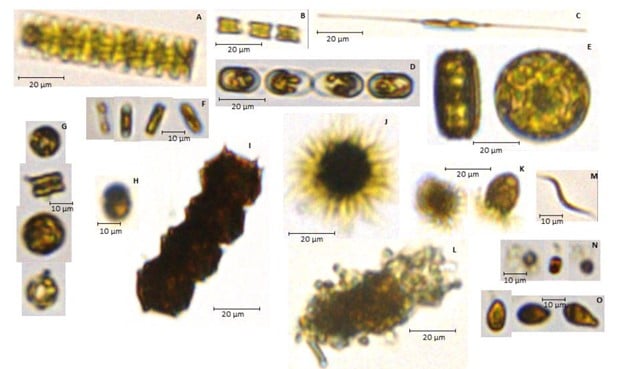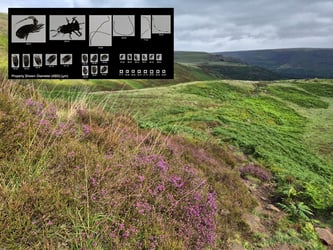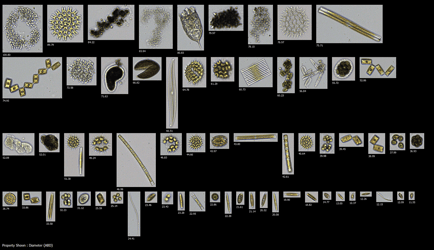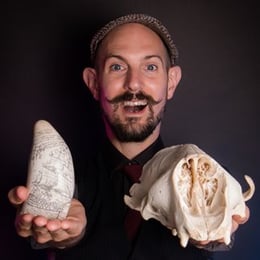
 Turbulence plays a key role in the mixing of lakes, seas, and oceans and inspired the subject of Dr. Russell Arnott's Ph.D. dissertation. With little to no background in biology, Dr. Arnott aimed to understand how fluid dynamics might impact phytoplankton communities and HAB distribution in aquatic systems. He was particularly interested in asking how turbulence and cell morphology might influence phytoplankton ecology - questions that challenged him to seek expertise from scientists outside his current discipline. Dr. Arnott found collaborators swirling into his research circle through unexpected intersections of water engineering, plankton ecology, microbial taxonomy, and marine environmental analysis.
Turbulence plays a key role in the mixing of lakes, seas, and oceans and inspired the subject of Dr. Russell Arnott's Ph.D. dissertation. With little to no background in biology, Dr. Arnott aimed to understand how fluid dynamics might impact phytoplankton communities and HAB distribution in aquatic systems. He was particularly interested in asking how turbulence and cell morphology might influence phytoplankton ecology - questions that challenged him to seek expertise from scientists outside his current discipline. Dr. Arnott found collaborators swirling into his research circle through unexpected intersections of water engineering, plankton ecology, microbial taxonomy, and marine environmental analysis.
Dr. Arnott soon learned about FlowCam technology and the value of shared knowledge among the diverse community of FlowCam users. First, through Rob Camp, the instrumentation and data technician for the Continuous Plankton Recorder (CPR) Survey department at the Marine Biological Association. Camp facilitated an introduction to Dr. Elaine Fileman, an experienced FlowCam user at Plymouth Marine Lab. She showed Arnott how to use FlowCam and connected him with environmental analyst Dr. Siv Huseby. In Dr. Arnott's words, "It was brilliant to be able to get data instantly and also be able to send images over to actual taxonomists. Special thanks as well to Siv Huseby at the UMEA Marine Science Center for help with the IDing".
Dr. Arnott's research evaluated the effects of small-scale fluid dynamics on the physical organization of morphologically diverse plankton cells. His mesocosm experiments used convection-induced turbulence to create various turbulent regimes ranging from quiescent, stratified systems to well-mixed systems. The objective was to determine a species-specific response to the different turbulent regimes and to what degree species morphology influenced the response. Enter FlowCam.
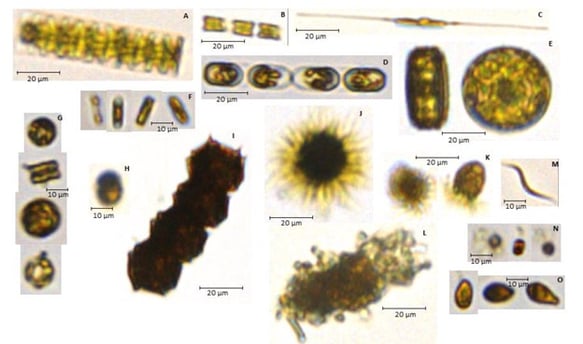
Some of the key species/groups identified in this study are pictured above:
A = Pauliella taeniata; B = Chaetoceros sp; C = Cylindrotheca closterium; D = Melosira arctica; E = Thalassiosira sp; F= pennate diatoms (pennales); G = centric diatoms (centrales); H = Gymnodiniales; I = Peridiniella catenata; J = Mesodinium rubrum; K = Oligotrichids; L = Tintinnid lorica; M = Monoraphidium contortum; N = small flagellates; O = large flagellates
Flow imaging microscopy with FlowCam helped Arnott build a statistical model that linked morphology to the turbulence-driven non-isotropic orientations of phytoplankton which may consequently influence ecosystem-level processes.
The FlowCam community came together to support the publication of Dr. Arnott’s Ph.D. dissertation from the University of Bath1 in the United Kingdom, The Role of Phytoplankton Morphology on Dominance Under Different Turbulent Regimes. FlowCam, and the wealth of knowledge from the FlowCam community, took Dr. Arnott's Ph.D. research in a direction he hadn’t anticipated, but like the turbulence effects on air and fluid, FlowCam led to the mixing of collaborators and the advancement of scientific research.
Funding for his Ph.D. was made possible by the Engineering and Physical Science Research Council (EPSRC, UK) while the mesocosm experiments were made possible using a grant from Aquacosm EU and the Royal Society UK.
Read Dr. Arnot's full dissertation:
https://researchportal.bath.ac.uk/en/studentTheses/the-role-of-phytoplankton-morphology-on-dominance-under-different
CITATIONS
1. University of Bath, UK - Centre for Infrastructure, Geotechnical and Water Engineering (IGWE) Department of Architecture and Civil Engineering.








